Contemporary artist Matthew Hansel challenges perspectives and toys with visual absurdity by layering imagery from classical European painting with warped cartoons, abstract forms and trompe l’oeil techniques.
I often quote from many types of historical image making, because my work deals with themes involving the compression of time through visual means.
Contemporary artist Matthew Hansel.

Artist portrait courtesy contemporary artist Matthew Hansel.
How do you describe yourself in the context of challenging people’s perspectives via your work and art?
I am a consumer of images as much as I am a producer. I’m fascinated with the way image making has changed in the past ten years in accordance with modern means of image distribution. I feel it is having a flattening effect on the contemporary gaze. The digital age has transformed the delivery method of images. While images remain tied to the time period in which they were made, the jumbled way in which they enter our consciousness leaves irregular historical and visual intervals between modes of representation. They arrive in a non linear, non historical, non hierarchical order. Artists are no longer required to choose sides or adhere to artistic movements or styles. We scroll through hundreds of images a day on screens that have rendered aesthetic camps irrelevant and ushered in an age of pluralism. The once clearly delineated shadows of our artistic forefathers have coalesced into a blur of equally sized pixels. This uniformity allows artists the freedom to order images as they choose, free of historic constraints and preexisting hegemonies.

Only Steal What You Can’t Afford. Contemporary artist Matthew Hansel. 60” x 48”, Oil and Flashe Paint on Linen. 2017.
I think there is parallel to be drawn between artists and comedians in this respect. Once an artist shows a body of work, there is a common feeling of artistic anxiety.
How do you deal with the conceptual difficulty and uncertainty of creating new work?
A lot of comedians speak about how scary it is when they record a comedy special because they can never do those bits again. Once that set of jokes is released to the world, on a large scale, the jokes are “burnt” and the comedians refuse to revisit them. They are forced to start over, writing new material until they have enough to fill a solid hour and record another special. This process of starting from scratch fills them with a sense of existential dread. There is an unfounded fear that they won’t be funny anymore or at least not as funny as they were last time.
I think there is parallel to be drawn between artists and comedians in this respect. Once an artist shows a body of work, there is a common feeling of artistic anxiety. Sitting in your studio staring at a blank canvas the week after a show opens can be quite intimidating. Constantly developing and honing new material is an expectation set for comedians and artists by their audiences. However, this expectation is enforced in the mind of the creator, which is daunting.
The important thing to remember is that you will always have more ideas. There will always be more concepts that you want to communicate. So have faith in yourself and trust the process. Rely on your craft and have confidence in your voice. You will be funny again.

In studio. Contemporary artist Matthew Hansel.
Tell us about the evolution of your practice over the years. What would you call your style?
I try to let my interests guide my practice. The adage, “Make what you want to see in the world”, has always been a useful one. I think the most difficult thing about having an artistic practice is maintaining it. Which, for a whole host of reasons is not always the easiest thing to do. So, it’s paramount to enjoy what you’re doing. I give myself the freedom to try new things and veer off course while making. I try to entertain myself or at least be open to the possibility of being entertained while working. It may sound a tad trite, and I’m not saying I love every minute in my studio, but when I do, it comes through in the work. I do quite a bit of conceptual meandering as well. Often my first idea isn’t my best one and many ideas (thankfully) never see the light of day.
My paintings literally and figuratively deconstruct the process of painting.
I’m not sure I have a style per se. I try to let the concept guide the way the work is made. I often quote from many types of historical image making, because my work deals with themes involving the compression of time through visual means. In this way, my work adopts the style of many time periods all at once. My paintings literally and figuratively deconstruct the process of painting. Layering imagery from classical European painting with warped cartoons, abstract forms and trompe l’oeil techniques, my work plays with visual absurdity and challenges perspective. The surface of the canvas is layered with images from disparate periods of time. Each object is specific in the form it takes and yet indicates the uncertainty that exists when anything is possible. The traditional hierarchies between images begin to break down and it becomes difficult to prioritise them in a conventional way. This leaves the work standing on the outside of any one style. Maybe the best term for it would be ‘Pluralism’.

Work in progress. In studio. Contemporary artist Matthew Hansel.
What inspires you? Let’s talk about your frameworks, references and process.
I’m inspired by the belief that art still plays an important role in how we understand the world around us and locating our place within it. When I was at Yale, I took the famous art theory course taught by the infamous Mel Bochner. Among many interesting ideas he had was the idea of art history as being a stream which had thousands of small tributaries.
An artist should think about where they are entering the stream. And once there, no longer a tributary, they are a part of the whole.
An artist should think about where they are entering the stream. And once there, no longer a tributary, they are a part of the whole. In this way, each work of art that was made before you affects every work of art you make. In return every work of art you make affects every work made before you. It’s a dialogue that exists between the living and the dead, the past and the present. My use of traditional European painting techniques and imagery is a way of acknowledging this symbiotic relationship. I’m talking about the creative process and the way time brackets our existence and our creative output. Each object and the way it’s created is tied to a moment. It carries with it its own history. My work is my attempt to, visually, collapse this time. I have little if any real relationship with the objects in my paintings. They aren’t particular to me. But when collaged together something emerges about the process or way of thinking about my small window to create, certainly not a self portrait, but a snapshot of a certain time as seen through the lens of an individual who happens to be me.

Exhibition view. Giving Up The Ghost. Contemporary artist Matthew Hansel. The Hole, New York, NY.
What were your biggest learning and hiccups along the way in your artistic journey?
It took awhile for me to find an audience. There were a lot of years of making paintings, letting them sit in studio and eventually un-stretching them so I could reuse the stretcher bars. Most of my work was never seen by anyone. In 2016, I started painting small porcelain figurines standing on the bottom edge of my paintings. They were always facing away from the viewer and toward the image. It was my way of building in an audience for the work, ensuring someone was always viewing the painting. It was a coping mechanism I suppose. Eventually I started to get actual eyes on the work and the figurines started working their way out of the paintings. However, one still appears from time to time, when I’m feeling especially uneasy.
I suppose I could offer some anecdote about patience and hard work paying off. But, nothing would have been more frustrating for me to read back when I was struggling to get anyone into my studio. The truth is I was lucky; lucky that I didn’t stop working, lucky that I had a supportive wife, lucky that I landed a residency which got me some exposure, lucky that people started looking at figurative work again, lucky that I’m still not painting (too many) porcelain figurines.
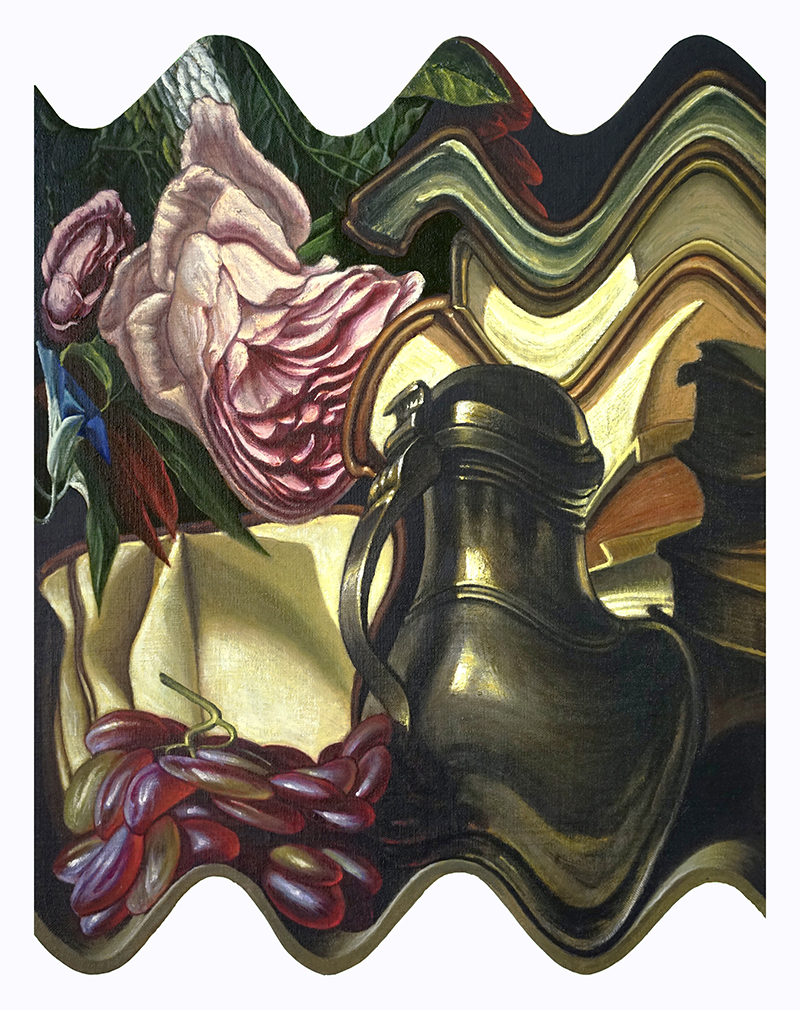
Where There Was No Pebble Tossed. Contemporary artist Matthew Hansel. 23” x 16”, Oil and Flashe Paint on Linen. 2019.
How does your audience interact and react to the work you put out into the world?
Being old enough to remember showing art before the age of social media, I can say that the way audiences interact with my work has changed entirely. For a long time, art was shown, for a limited time, almost exclusively in a gallery environment. You interacted with people at your openings and occasionally someone would choose to write about your work. It was a very limited way of receiving feedback. In fact, I can remember my art school professors saying, “You better take advantage of all the studio visits and feedback you’re getting on your work because after school, it will be very difficult to maintain this type of dialogue.” – and they were right.
However, today there are inexhaustible ways of connecting with collectors, artists, gallerists, curators and complete strangers. While there’s no substitute for a serious and constructive studio visit from a trusted person, technology has broadened my opportunities to connect and interact with others, immensely. Social media, artist’s websites, podcasts, auction sites, platforms like this, art fairs, email, FaceTime, Skype, etc. are all part of artists’ repertoire at this point. It makes you wonder how you ever survived without it.
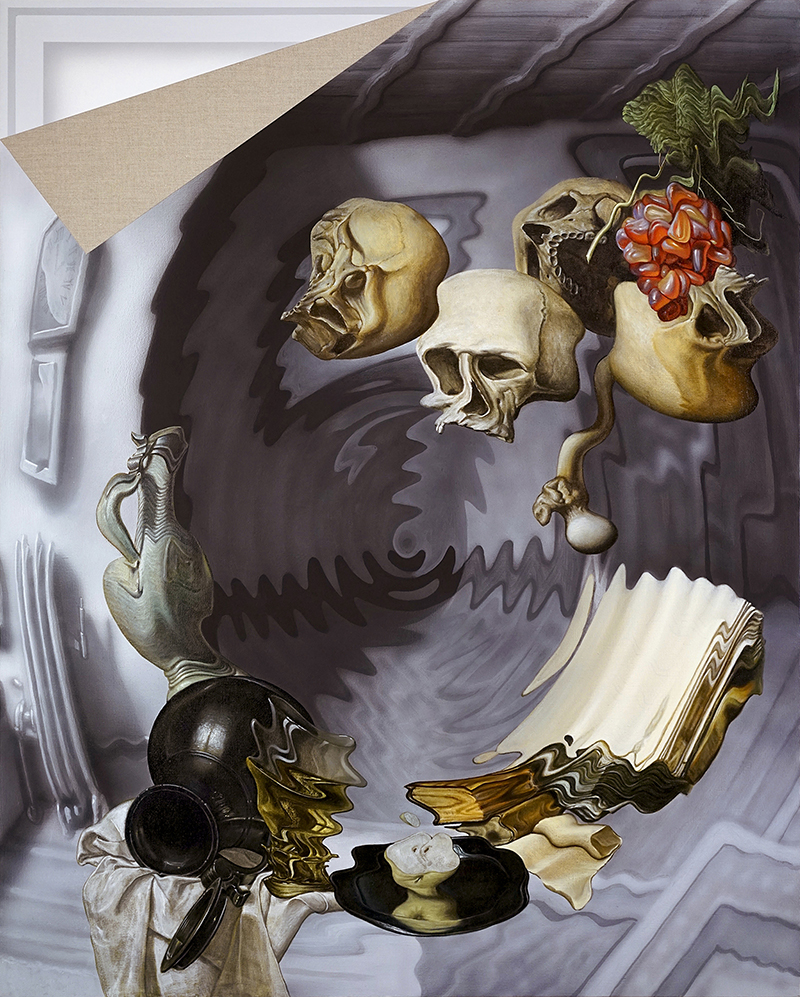
The Studio. Contemporary artist Matthew Hansel. 48” x 38”, Oil and Flashe Paint on Linen. 2017.
What are you working on during this lockdown? How are you balancing life and work at home during the lockdown?
I’m extremely lucky to be healthy, have a loving family and a support system that many others don’t. The lockdown has been more of an inconvenience to me. Being someone who likes to stay busy, I am often bored. I realise that only the extremely fortunate have the luxury of being bored right now. That said, I have been trying to home-school my daughter, work out in our apartment and find time to get to the studio. I’ve been eating too much and definitely drinking more than usual. I have been making work, but at a much slower rate than normal. I am anxious for things to return to normal so I can get back to a more rigorous studio schedule. On the flip side, it has been great to spend more time with my wife and daughter. We haven’t been together so much as a unit since she was a newborn.

Exhibition view. Art Is Where The Hearst Is. Contemporary artist Matthew Hansel. Galerie Droste, Wuppertal, Germany.
What is there a crying need for in the art world today?
Right now the art world is crying for the same thing the rest of the world is crying for – a medical resolution to this virus. At the heart of it, the art world is an interaction between people and objects. It depends on being present and experiencing things in person. The sooner we can get people back in front of real art objects the better.
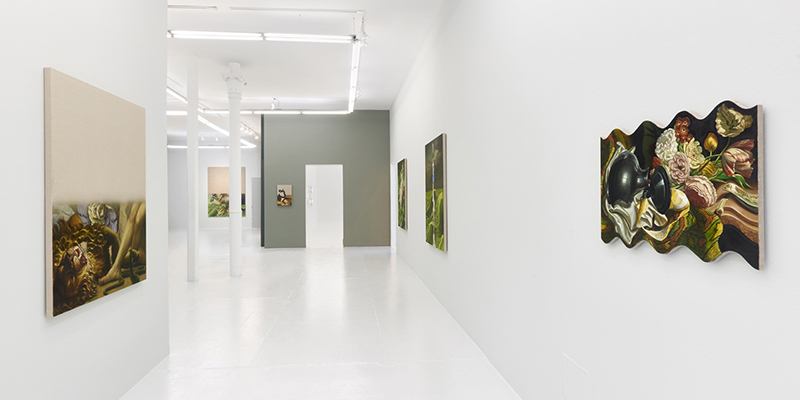
Exhibition view. Giving Up The Ghost. Contemporary artist Matthew Hansel. The Hole, New York, NY.
What would elevate artists’ life during this period?
Since social distancing seems to be something that will be with us for awhile, the traditional studio visit seems to be in need of an update. I think devising a way to host and promote virtual studio visits to a select group of people would be very helpful. It would be great to have a team behind the site reaching out to collectors, curators and dealers who might be receptive to the work. I think this would also be a great way to reach people who live in other countries and parts of the country who wouldn’t be able to visit an artist’s studio in person.
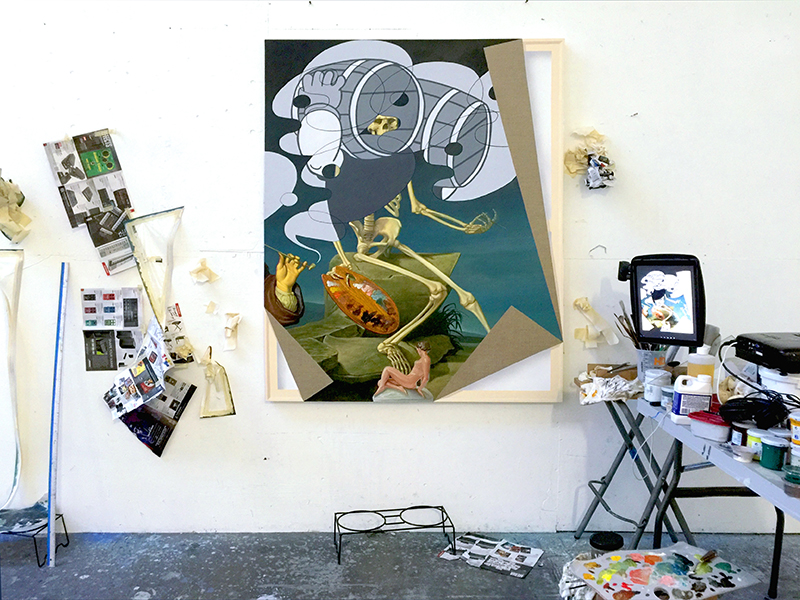
Studio View. Contemporary artist Matthew Hansel. Hooper Projects, Los Angeles, California.
Tell us about your studio, what kind of place is it? Could you describe your usual work-day in the studio?
My studio is a modest room in an old Brooklyn factory. There is nothing remarkable about it – four walls and a small window, but I love it. It’s my space to go and work, uninterrupted by the outside world. I’m grateful to have it and I don’t take it for granted. When I graduated from Yale and moved back to New York, I was painting at an easel set up at the foot of my bed. I went to bed every night staring at a painting and woke up to it looming over me in the morning. I worked out of my apartment for over ten years before I was finally able to get a studio. Now I’m in my studio five days a week. I drop my daughter off at school, hit the gym and am in the studio by 10:30. I usually do most of the preparatory work on my computer so I can hit the ground running. I listen to music and podcasts and rarely leave the easel before it’s time to head home. I’m home by 6:30 and usually on my computer prepping again after my daughter goes to bed.
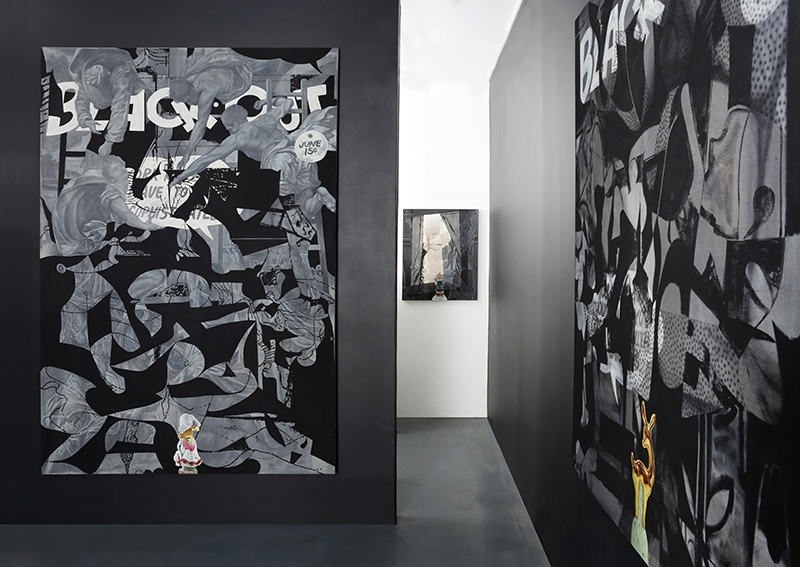
Exhibition view. Contemporary artist Matthew Hansel. BLACKOUT. Yours, Mine & Ours, New York, NY.
How many works do you make in a year? How many would you like to be making?
I’m a fast painter and I spend as much time as possible in the studio. The recent lockdown aside, I am in the studio five days a week. I don’t have a tally going, but I usually take a week or two to finish a painting. Of course, I’m not a machine, so my output varies. I don’t have a clear goal of works I’d like to finish in a year. But, I can say that I’d like to spend even more time in the studio, which would result in more finished paintings. So, I guess the answer is more.
Before you go – you might like to browse our Artist Interviews. Interviews of artists and outliers on how to be an artist. Contemporary artists on the source of their creative inspiration.












Add Comment